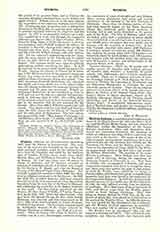

Wichita Indians, a confederacy of Caddoan stock, formerly dwelling between the Arkansas River, Kansas, and the Brazos River Texas, and now located in Oklahoma, within the boundaries of the former Wichita reservation. They call themselves Kitisch and sometimes Tawehash, the meanings of which are unknown, and claim to have come from the same stock as the Pawnee. The names of nine of the tribes formerly composing the confederacy have been preserved, but the only divisions now existing are the Tawakoni, the Waco, and the Wichita proper. Previous to the annexation of Texas (1840-5), the Wichita proper dwelt north of the Red River and around the Wichita Mountains. The meaning of the name Wichita is unknown. These Indians were first met about 1541 in Quivara, during the expedition of Francisco Vasquez De Coronado (q.v.). Fray Juan de Padilla, who accompanied Coronado, and some companions remained with these to evangelize them, and three years later gained the palm of martyrdom. In 1719 the Wichita were visited by La Harpe, a French soldier, who found them given to cannibalism; somewhat later they were forced to the southwest by the Osago and Chickasaw. In 1758 they destroyed the Spanish missions of San Saba, near the Rio Colorado. In 1801 the tribe suffered severely from an epidemic of small-pox. Their first treaty of peace was made in 1835, and fifteen years later the Wichita proper settled at Rush Springs, Oklahoma. They took refuge in Kansas during the Civil War, on the conclusion of which they were placed on a reservation to the north of the Washita River. In 1902 the reserva-tion was opened by the Government for Settlement, and the Wichita received allotments in severalty. They now number 310, in addition to 30 Kichai.
The Wichita were an agricultural tribe, but also engaged in hunting the buffalo. They cultivated corn, pumpkins, and tobacco, which they bartered with their neighbors. Their permanent dwellings were cone-shaped, with a diameter of from fort y to fifty feet, and were thatched with grass; when travelling they lived in skin tipis. Before coming under the influence of civilization their dress was very scanty; they tatooed their faces, arms, and chests, and so were called the “tattooed people” by some of the other tribes, thus: Doguat or Tuchquet (Kiowa), Dokana (Comanche), Hochsuwitan (Cheyenne). They were a steadfast, peaceful race, given to ceremonial dances, particularly the Horn dance and the Gift dance, and also held foot-races in which all the tribe competed.
A. A. MACERLEAN

